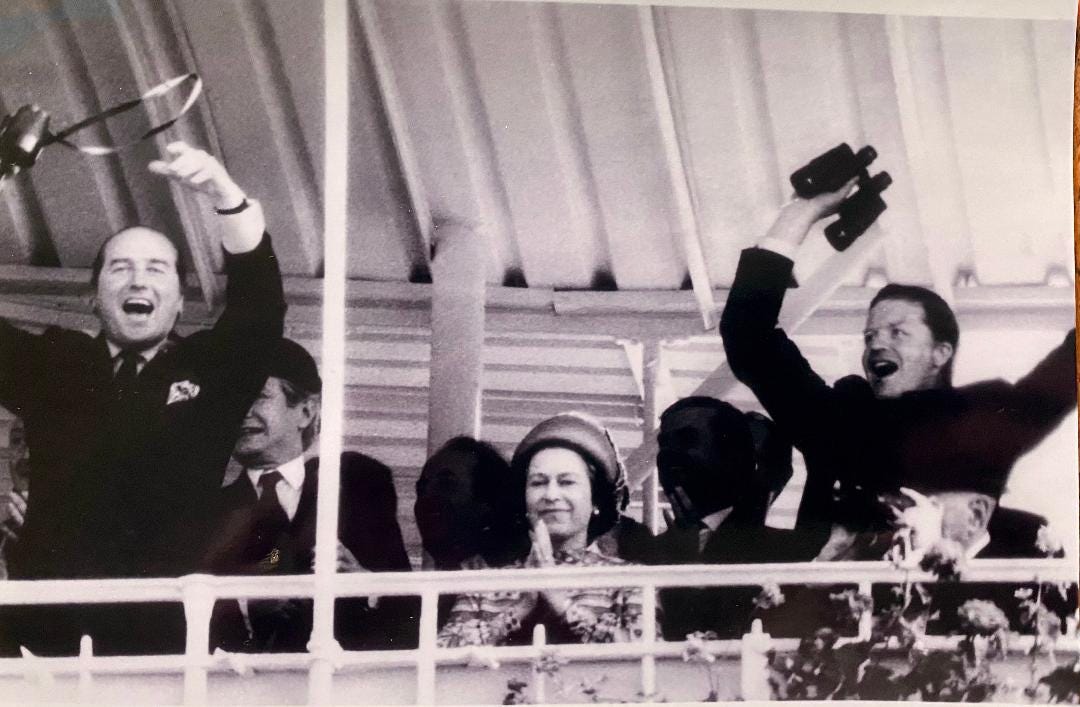In its final season, The Crown returns to the Queen's friendship with "Porchey," her racing manager for thirty years
They spent happy "working holidays" in Kentucky's Bluegrass Country, captured in photographs I am sharing for the first time
As viewers wend their way through the sixth and last season of The Crown, they are being reintroduced to Henry George Reginald Molyneux Herbert, the 7th Earl of Carnarvon, who turned up in the first three seasons. In each of those instances, the series implied that the Queen and her longtime friend— nicknamed “Porchey” after the Lord Porchester title he held until he inherited the earldom in 1987—were having an affair.
While that innuendo had no basis in reality, The Crown’s creators spun it into various invented scenes, imagining that Porchey made Prince Philip jealous. In one plotline, the Queen and Porchey visited Kentucky together for several weeks to explore new breeding techniques for her stable of thoroughbreds. They were depicted as savoring their horse racing bond a tad too closely until their idyll was interrupted by the Queen’s summons back to Britain on urgent business. “Somehow today has managed to be one of the most enjoyable days of my life, and at the same time, one of the most depressing,” Olivia Colman as the Queen told John Hollingworth as Porchey. The Crown has Colman implausibly explaining the reason for her sadness: she had been experiencing her “unlived life” of quietly breeding, training, and racing horses with a like-minded man rather than fulfilling her duties as monarch.
Fact and fiction commingle
In the sixth and final season released on December 14th, Porchey appears with then-Princess Elizabeth in a flashback to VE-Day in 1945, and in 2001, the Queen tells her ailing sister, Princess Margaret, that Porchey has died of a heart attack while watching the news of the 9/11 terrorist attack. As with much of The Crown, fact and fiction commingle: The Crown shrinks the group of sixteen on VE-Day to four and has Elizabeth dancing wildly at the Ritz instead of snaking quickly through the hotel as part of a conga line. Porchey did in fact die as recounted in The Crown.

In researching my biography, Elizabeth the Queen: The Life of a Modern Monarch, I steeped myself in her life as a thoroughbred owner and spoke to many people in the horseracing world. Given the depiction of Porchey in The Crown, it’s worth clarifying the Queen’s relationship with him—and equally with his wife Jeanie, who I interviewed at some length. One of the most fascinating aspects of this friendship was the surprisingly strong connection to the United States, including five visits to Kentucky—in 1984, 1986, 1989, 1991, and 2007. They were the only private vacations Elizabeth II took outside her own estates in England and Scotland during her seventy-year reign. The first four of those visits were closely managed by Porchey.
Porchey’s mother was a New Yorker named Catherine Wendell. The former Jean Wallop grew up in Wyoming; her paternal grandfather, the 8th Earl of Portsmouth, had married the daughter of a Kentucky judge and settled in the American West. Henry Porchester and Jean Wallop were introduced in 1955 by her first cousin Micky Nevill (a friend since childhood of Queen Elizabeth II), also an Anglo-American: “My proudest accomplishment,” Micky told me. Porchey and Jeanie married in 1956 and quickly became part of the exclusive social set around the Queen and Prince Philip.
Kentucky entered the picture after the Queen appointed Porchey—a friend since they were teenagers in the 1940s—as her first racing manager in 1970. She also named Sir Michael Oswald as the manager of the Royal Stud on her Sandringham estate. She and her racing advisers knew that they could only make real progress by taking advantage of superior American breeding stock.
Bring in new blood
Porchey began sending Elizabeth II’s mares to Kentucky to mate with the world’s best stallions in an effort “to bring in new blood.” In 1984 they decided to arrange her first private “working holiday” in the Bluegrass state. The 58-year-old Queen would spend five days around Lexington visiting her mares at the top stud farms and inspecting more than sixty stallions for possible mating. Her hosts that autumn and for each of her subsequent trips were 45-year-old William Stamps Farish III and his wife Sarah at their 1,400-acre stud farm, Lane’s End, in Versailles (pronounced Ver-SALES) near Lexington.
Originally from Houston, Will had inherited a fortune from Humble Oil (later Exxon) and Sears Roebuck, and Sarah was a du Pont heiress. The Farishes had moved to Kentucky in 1963 and in the following decades had built a world-class thoroughbred operation with modern facilities including customized “elliptical” fences without corners that could injure the horses. The legendary horse breeder Paul Mellon, a close friend of the Queen, had introduced her to the Farishes, with the assurance that they would be congenial and discreet.
Although it was a private visit, the Queen’s itinerary was mapped out minute by minute by the British Embassy and Catherine “Bundles” Murdock, a State Department protocol officer who had grown up in Virginia’s horse racing community. Despite all the planning, the Queen nearly wasn’t admitted to the United States when her flight landed in a downpour at Lexington’s Blue Grass Field on October 7, 1984.
Keep reading with a 7-day free trial
Subscribe to ROYALS EXTRA BY SALLY BEDELL SMITH to keep reading this post and get 7 days of free access to the full post archives.



